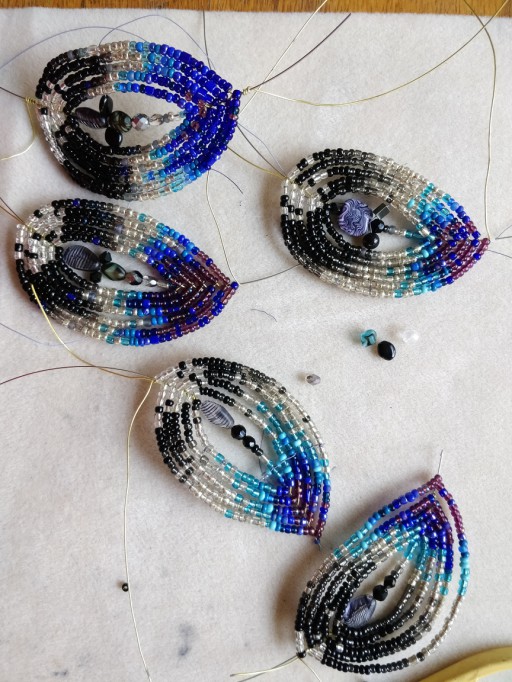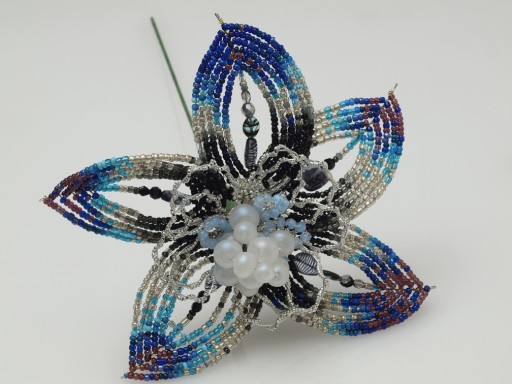I'm supposed to be teaching a french beaded flower class shortly, but because of the way the class is being funded, it's limited to seniors, and both the person who commissioned me to teach the class & I had concerns about students being able to manipulate the traditional size of beads used in this technique—11/0s.

in progress. 7may2018. 20 ga brass, and 20 ga 308 stainless steel wire for the petal construction with scraps of grey 26 ga parawire serving for lacing. The focal bead on the upper right petal was a gift from fellow beadworker Rita Stucke.
I had my doubts about sizing up to 8/0s, however, because they would require thicker, and therefore stiffer, wire. However, I had a bunch of 8/0s in silver-line, black, blues and violets, and wondered if they could be made to work. Instead of using the traditional 24 ga paddle wire (which being steel is much stiffer than the copper coated craft wires that are the current standard) I decided to use 20ga stainless steel 308 wire that I bought, um, about 30 years ago to make pins. As it turns out, it's also suitable for bead-making, though since this gauge is wound on a spool it's too curly for mandrels. But for making glass doodads on wire? Perfect.
With such a super-stiff center rib, it didn't matter how soft the 20 ga brass wire was—and that's also been hanging around semi-uselessly for 30 odd years. Although I could have easily strung 8/0s for the (entire) center rib, I wanted to see if I could incorporate some larger beads, such as the striped flattened teardrops. I tried stringing other beads, such as the black ovals, onto the lacing wire, but it was really ugly, so I cut that back off.

pixie dust beads, 6mm blue beads, seed beads, aluminum, brass and steel wire. Flower is about 8" across. Photographed 7 may 2018 E620.
Ultimately, my attempts to incorporate larger beads was not terrifically successful. Nor did I do any Rivoli style colour mixing. I also wanted to try doing wrapped wire frame that a lot of Victorian funerary wreaths and arrangements, as it's a nice texture and visually interesting. I didn't have quite enough wire for 10 petals, so I did doubled wrap around loops for the first 4, a single for the last one, then pulled them apart to disguise that I was one short. The center needed more drama to balance the hand-shaded petals[1] so I added a bunch of 6mm ‘moon’ beads left over from the first beadcurtain days made into a set of wrap around loops and a bunch of pixie dust beads from a necklace long since cut apart for the center. Thus, the piece consists of 4 layers, stacked as follows:
- center, of lampworked white pixies
- 6mm moon bead rounds, shaped into a continuous single wrap around loops;
- silver coloured seed beads twisted around aluminum wire, and made into continuous double wrap around loops, which were then pulled apart and separated;
- 5 petals, Basic frame on a central rib, round bottom, pointed top with fancier beads on the rib.
[1]IOW, I worked with a cut piece of wire, adding half a row of colour at a time so I could maintain perfect control over the blending—as opposed to pre-stringing the beads on the spool. It's an attractive but much slower technique.
Unless otherwise noted, text, image and objects depicted therein copyright 1996--present sylvus tarn.
Sylvus Tarn